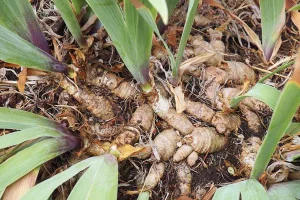 There’s almost nothing that gardeners like more than free plants. And chances are pretty good that your own garden is a great source for them. My most rewarding gardening chore is in the springtime when I divide and transplant clumps of bulbs and perennials.
There’s almost nothing that gardeners like more than free plants. And chances are pretty good that your own garden is a great source for them. My most rewarding gardening chore is in the springtime when I divide and transplant clumps of bulbs and perennials.
Most of them benefit from being divided every few years, anyway. They tend to get really crowded and flowering slows down. Some will even tell you when they want to be divided. As the clump grows larger, the center becomes barren, and you have a donut shaped clump. At this point, dig up the clump and discard the barren center, and separate the donut into as many plants as you like. Naturally, the larger the piece you transplant, the sooner you’ll have a nice display of flowers.
I’ve mentioned in previous columns that plants have memories. They remember whether or not they’re mature and plant divisions don’t need the year or two to flower as do most perennials grown from seeds.
Don’t bother to save seeds from hybrid plants – they don’t come ‘true’ from seeds. Dividing and taking cuttings are the only ways you can successfully propagate them. Division is far more successful than cuttings; at least for me.
Agapanthus divisions are easy to make, but they do take a couple of years to settle in and bloom. They like to be root bound and that takes a while. Daylilies have similar root structure and are just as easy to divide. In fact, it’s really hard to kill a daylily! I made some divisions several years ago, but was too tired to transplant them that day, so I put them in the back of my garden shed where I forgot about them. I found them who knows how many years later, but they didn’t look all that dried out, so I planted them anyway. They forgave my neglect and have bloomed every year since.
A word about daylilies. They come in dormant, semi-dormant and evergreen varieties. Down here our winters are mild (usually), so the dormant and semi-dormant varieties don’t get the winter rest they need and don’t really thrive. Evergreens are the best, but semi-dormant will usually do OK. Unfortunately, plant labels don’t tell you which they are, so if you’re shopping, take out your phone and look up the cultivar name at the American Daylily Society website https://daylilies.org/DaylilyDB/ and it will tell you. Just FYI, there are more than 80,000 registered daylily cultivars, and hundreds more every year!
Most bulbs will provide offsets, or baby bulbs, which are attached to the mother bulb. Gently pull the baby bulb away from mama, making sure that there is some basal plate at the bottom of the baby. If the baby bulb is really small, just put them both back in the ground until next year.
If you have a stout heart, you can actually cut bulbs into halves or quarters, making sure that each piece has some of the basal plate. The new roots will grow from there. Dust the cut edges with cinnamon before replanting. It’s a great fungicide and the aroma will make you want to go inside and bake cookies.
Amaryllis bulbs respond well to this treatment. Good thing, too, since they are usually quite expensive. The after Christmas sales are good times to stock up, even if the selection is limited. These bulbs are large enough to withstand being out of the ground for much longer than other bulbs.
Lily bulbs are different. They are much like artichokes, with each ‘leaf’ having the ability to become a new lily. Just peel off a few leaves and put them in a baggie with some moist potting soil. In a few weeks, they will have produced roots along the base of the leaf and can be potted up. They produce offsets, too. They don’t have a protective coating like tulips and amaryllis and they don’t ever go completely dormant, so they don’t last as long out of the soil as others do.
Most perennials simply clump up, with roots that are intertwined. You can often just cut off a section of the plant with a sharp spade without digging it up. Ornamental grasses have those kind of roots, as do asters and many other perennials.
If a friend offers you a free plant, make sure that it really is a plant you want, and not one that’s a thug which will take over your garden (possibly the reason your friend has so many to give away?). I accepted a Clerandron bungei (Cashmere Bouquet or Glory Bower) and have lived to regret it. I mean really really regret it.
Some shrubs can send out ‘runners’, which will often take root, and these can be severed from the mother plant. If you have a shrub that’s hard to find and you want another, you can usually ground layer it. That is, take a long, pliable branch, scrape a bit of bark from it and lay it in a trench, covering it with soil and something heavy to keep it in place. After a few weeks, it can be cut from the mother plant and transplanted. Not exactly dividing, but kinda’ sorta’. And it’s still a free plant.
Just think what all those free plants already in your garden would be worth if you had to buy them.
You’re welcome.
Gardening Tip. Before you begin gardening, and even before you put on your garden gloves, scratch your fingernails across a bar of soap. Makes cleaning your nails so much easier!








